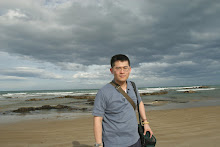This sea cave along the Bunurong Coast has long since collapsed, its vault surrendered to the sea. Looking back, I am grateful to have captured its likeness when it still stood—through the wide and wondering eye of my beloved Laowa 9mm f/5.6 lens. There is a certain dreamlike distortion in that image, as though the rocks themselves breathed and swayed beneath the ocean’s spell.
The Bunurong Coast, stretching eastward from Inverloch toward Cape Paterson in southern Victoria, bears the ancient imprint of time and tide. Its cliffs, carved from Cretaceous sandstone, reveal layers of the earth’s deep past—here, the footprints of dinosaurs once pressed into mud more than a hundred million years ago; there, fossils of giant ferns whispering of the age before man. Long before European discovery, this rugged shoreline was home to the Bunurong people of the Kulin Nation, who lived in harmony with its rhythms. They fished its rock pools, gathered shellfish from its tidal flats, and told stories of creation woven with the waves and wind.
Today the coast remains a place of austere beauty—where history, both human and geological, converges in the song of the surf. Though the cave itself has fallen, its spirit endures in memory and in the photograph: a fleeting vision of what once was, suspended between earth and sea, and rendered eternal by the lens.






























